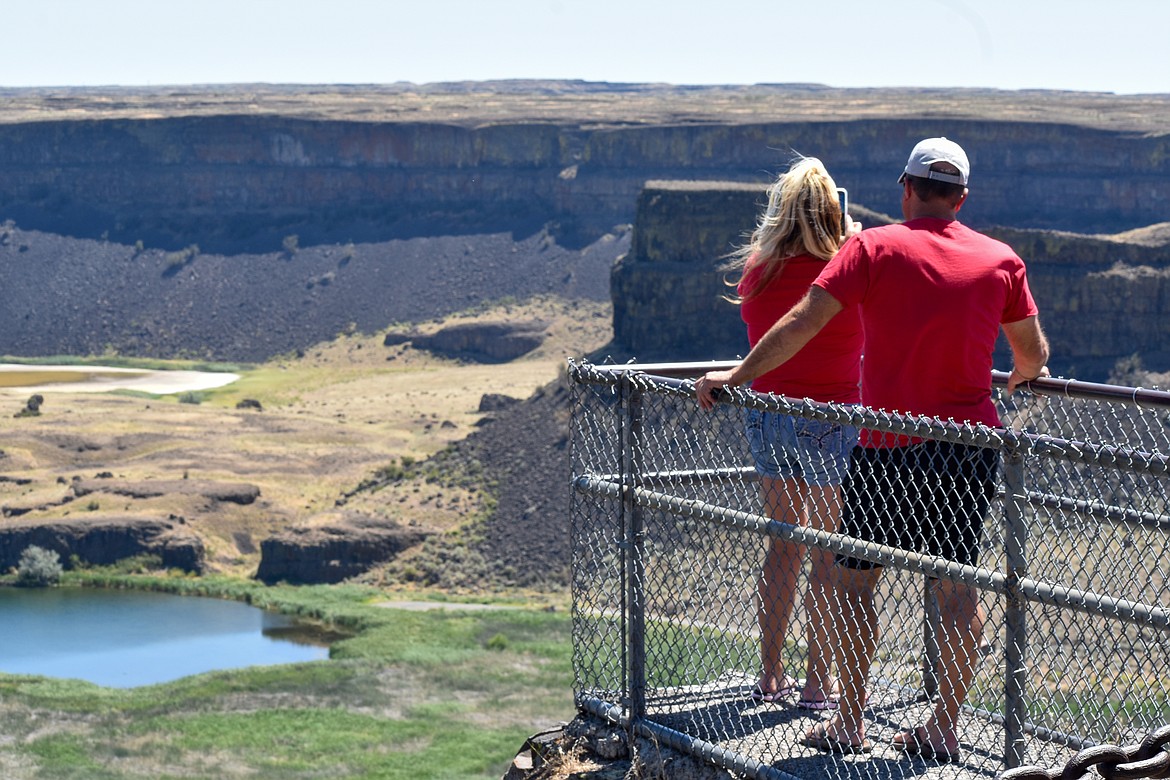Floodfest floods Dry Falls Visitor Center with guests
COULEE CITY — Ice Age Floodfest returned to the Dry Falls Visitor Center over the weekend, attracting a wide array of people interested in celebrating and learning more about the history of the unique geology of the area.
Floodfest is an annual event hosted by Washington State Parks at the Dry Falls Visitor Center to educate and celebrate the ice age floods that created the landscape along the Coulee Corridor. Other groups and organizations participated in the event with interactive booths and presentations set up around the grounds of the visitor center. The event has been hosted annually for over a decade but had a brief hiatus during the COVID-19 pandemic.
“A Geology of the Grand Coulee Dam Area,” by the Bureau of Reclamation addresses what created the channeled scablands of the Columbia Basin, starting about 65 million years ago through lava floods and tectonic plate movement, but which was greatly impacted by the last ice age. When Lake Missoula burst through the ice sheet that had created it, the result was water rushing at speeds of up to 65 miles per hour across the landscape of northern Idaho and eastern Washington and into western Oregon. It stripped away soil, leaving canyons and marks in the landscape that made the Columbia Basin the way it (mostly) looks today.
Part of the landscape left is perfectly exemplified at Dry Falls where there is a viewpoint to a large coulee that is 400 feet high and 3.5 miles wide — five times the width of Niagara Falls – that had been the world’s largest waterfall when the Ice Age floods poured over the edge into the coulee.
Chad Eidson, a wildlife area manager with the Washington Department of Fish and Wildlife, had a booth featuring furs, skulls and tracks of species that call Washington home. They included a skunk, bobcat, deer, fox, coyote and raccoon, among others.
“It’s fun to look at skulls and hides and tracks,” said Eidson. “Get folks some exposure to some animals that are on the landscape.”
Eidson said that while not all the animals he had in his display call the Coulee Corridor home, education about species native to Washington state is still important.
"A huge part of what we do is wildlife landscapes; I mean my job as a wildlife area manager — we manage 192,000 acres of land for the purpose of wildlife habitat — we want wildlife on the landscape so educating folks and interpretive opportunities is a great way to get folks interested," Eidson said.
Another important aspect of Columbia Basin history is not only what shaped the land but also who. The lands of the Columbia Basin were home to tribes of indigenous peoples who lived, hunted and gathered in the region.
Lucille Luevano, an enrolled member and historian of the Confederated Tribes of the Colville Reservation, gave an oral history about the area and had a poster board with historic photographs including photos of the last recognized chiefs.
The last recognized chiefs and their tribes, as prepared by the Confederated Tribes of the Colville Reservation History Archaeology Program, were Chief Chiliwhist Jim (Methow), Chief Long Jim (Chelan), Chief John Harmelt (Wenatchi), Chief Silicosasket (Entiat), Chief Moses (Moses-Columbia), Chief Tonasket (Okanogan), Chief James Bernard (Lakes), Chief Kinkanaqua (Colville), Chief Jim James (Sanpoil), Chief Nespelem George (Nespelem), Chief Joseph (Chief Joseph Band of Nez Perce) and Chief Cleveland Kamiakin (Palus), according to Luevano.
Luevano said she comes down to Floodfest in her indigenous attire, because she wants people to know that indigenous people still exist and still practice their culture and traditions.
"I like to come down here so that the people know that we’re still here,” Luevano. “I have to walk a balance. In the white man world, I have a job, a 10-hour-a-day job Monday through Thursday, and I also raise my kids. They go to public school but then I also have to remind them ‘When you come home you take off your shoes at the door and you put on your moccasins. We’re Native Americans, we’re Indian.’”
She added that her people still gather their traditional foods and expressed a hope that people are more aware and careful about being good stewards of the land when it comes to development and pesticides.
"We still, my family — my children, I, my mother and my grandparents — we all practice our culture and we still gather our traditional foods,” Luevano said.
For more information about the Confederated Tribes of the Colville Reservation, visit colvilletribes.com.
For more information about the Dry Falls Visitor Center or Washington State Parks visit parks.wa.gov.
Rebecca Pettingill is a freelance writer and photographer based in Soap Lake. Send your news tips to editor@columbiabasinherald.com.













